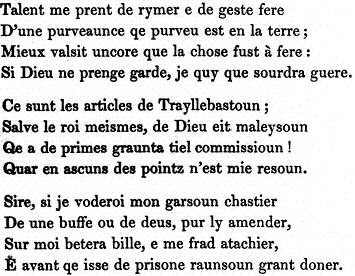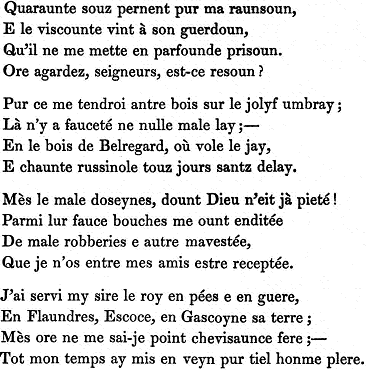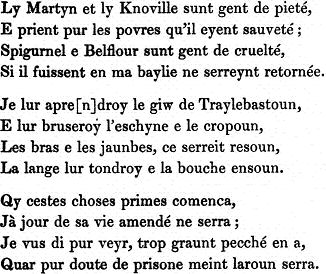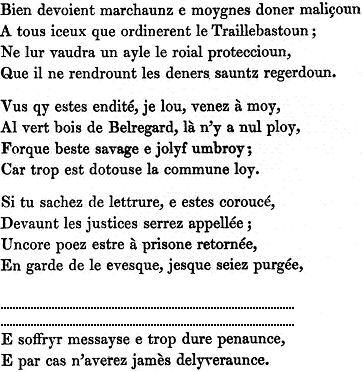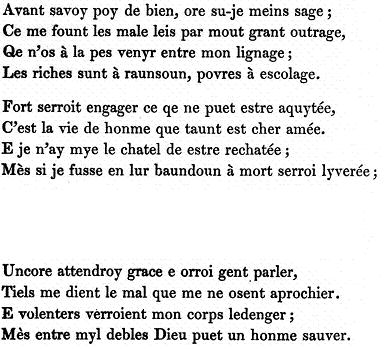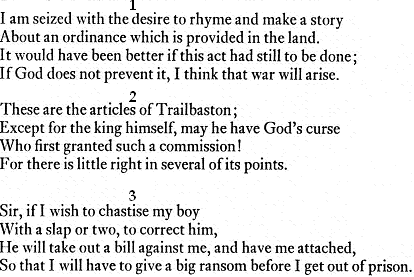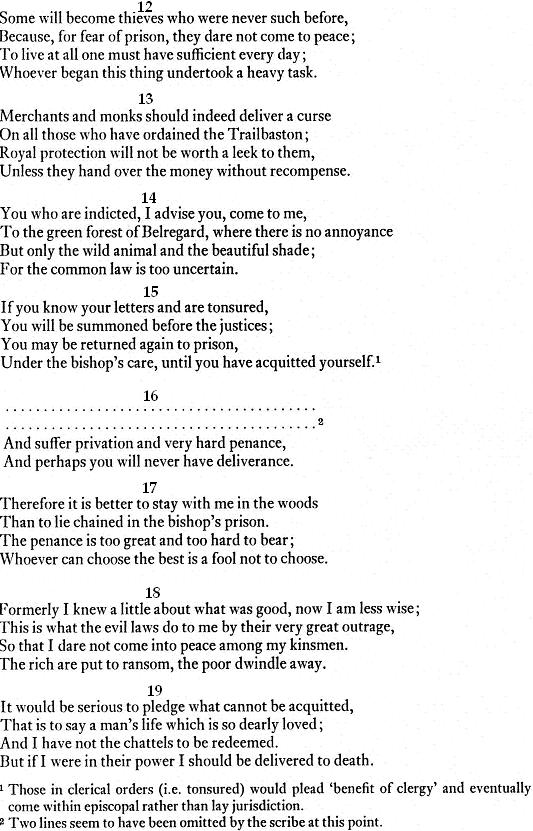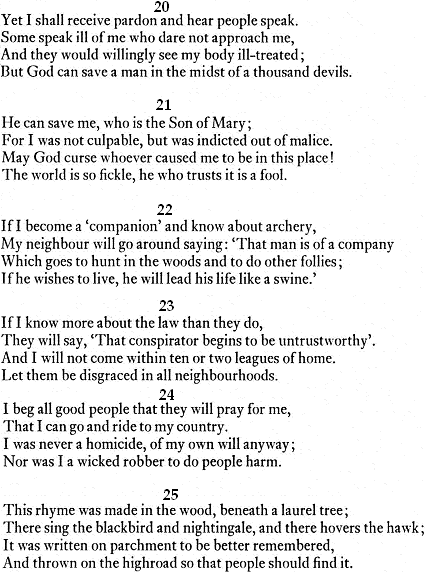The Outlaw’s Song of Trailbaston
This poem is untitled in the original text, and consists of twenty five four line stanzas, all rhyming AAAA. It is preserved in an early fourteenth- century manuscript which contains a collection of Middle English lyrics. Written in Anglo-Norman, the language used in early fourteenth-century law courts, it could be called a political statement by the author on the unjust newly introduced commissions of trailbaston. These consisted of groups of justices specially appointed to prosecute and punish armed criminals, (‘trailbastons’) who were guilty of acts of robbery, assault, and terrorization against the king’s subjects. The first commissions of trailbaston date from 1304-5 and were repeated, in spite of opposition, throughout the fourteenth century(1) In stanza 9, direct reference is made to William Martin, Gilbert de Knovill, Henry Spigurnel and Roger de Bella Fago, who were justices of trailbaston assigned to the south-western counties in April 1305; this suggests the probable date of the poem and the probability the author lived in that part of England.(2) According to the author, the poem was written on parchment, then dropped on the high road so that it might fall into the hands of travellers. It is possible that the supposed outlaw that wrote this poem was actually a well-informed member of society who had concocted a work of political propaganda; he presumably served in Edward I’s military campaigns (stanza 7). His claim that he knew the law as well as his legal persecutors (stanza 23) seems confirmed by his correct use of legal terminology, which could suggest that he was possibly a knight or an esquire or more probably (see stanzas 15-17) a well-connected clerk. The Outlaw’s Song could not be considered a popular poem, more likely it was a work intended for a local audience, however it does throw some light on aspects of late medieval English social thinking: Outlawry is assumed to be the result of intrigue, false accusation and local oppression rather than of deliberate crime (stanza 24); the lawless ‘compagnie‘ or band of men (stanza 22) is already a well-known feature of the English forest; and the outlaw himself is on balance, presented as a sympathetic and unjustly persecuted individual.(3) Here we can see some promotion in the early evolution of the Robin Hood legend. On the evidence of this poem there is the suggestion that at the beginning of the fourteenth century, a number of the upper classes and the clergy, had come to admire and associate themselves with the deeds of the ‘noble outlaw’, whom Robin Hood would come to represent above all others.
1. The most fully recorded opposition to the commissions of trailbaston came not from the lowest orders of society, but from bishops and parliamentary knights of the shire: see M. McKisack, The Fourteenth Century (Oxford 1959) pp. 171, 200, 206. These commissions were a variation of the general royal judicial commissions of oyer and terminer, and apparently gave justices the additional power of deciding suits between parties, they could be ‘easily used as declarations of war by particular groups in the community against other groups’: A. Harding, The Law Courts of Medieval England (London, 1973), p.90.
2. I. S. T. Aspin, pp. 67-8.
3. Cf. Stones, ‘The Folvilles of Ashby-Folville’, T.R.H.S., 5th. series, VII (1957), pp. 117-36; Bellamy, Crime and Public Order, p.82.
Source: British Library, Harley MS. 2253, fos. II3v-II4v.
Editions: T. Wright, ed., The Political Songs of England (Camden Society, Old Series, VI, 1839), pp. 231-6; I. S. T. Aspin, Anglo-Norman Political Songs (Anglo-Norman Texts XI, Oxford, 1953), pp. 67-78; Dobson and Taylor, Rymes of Robyn Hood, 1976, pp. 250-254.

|
